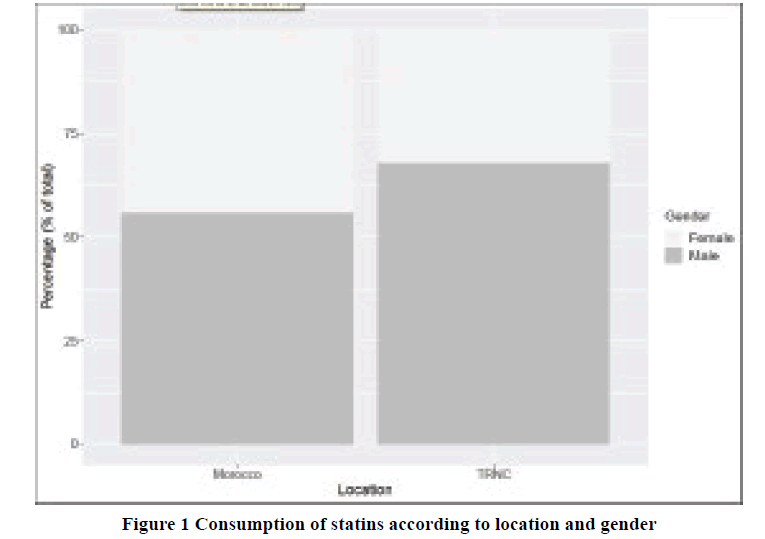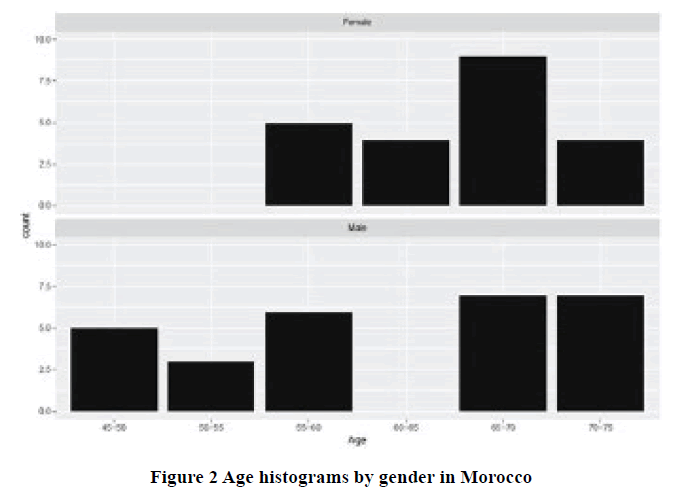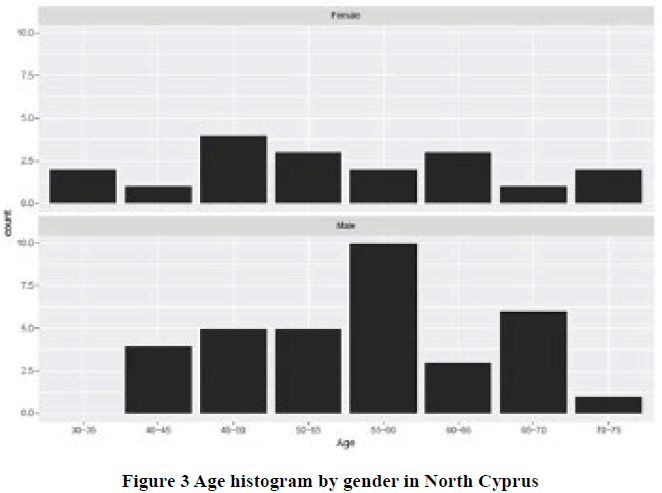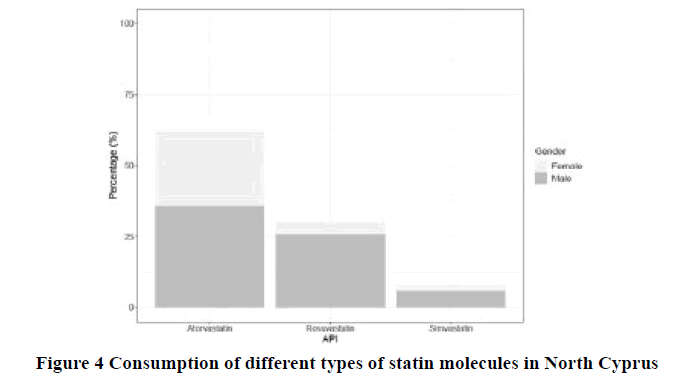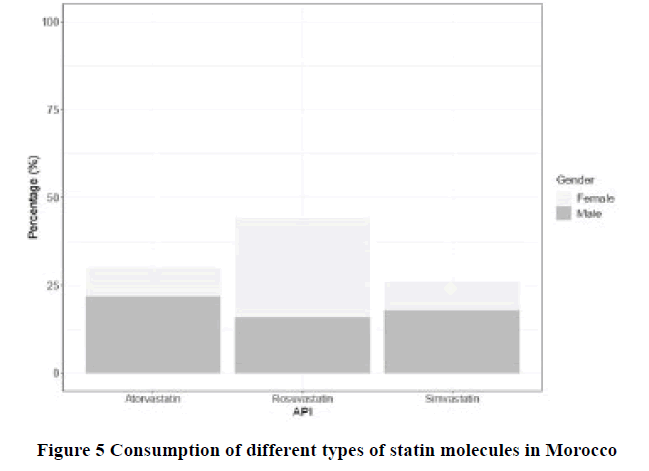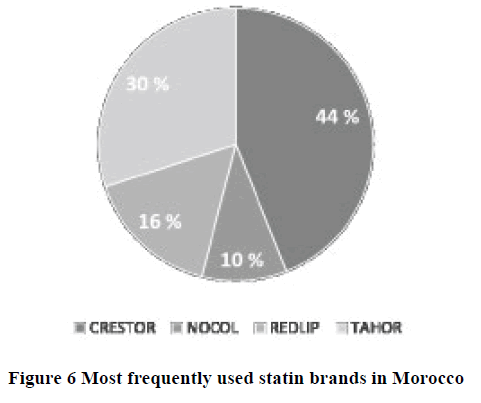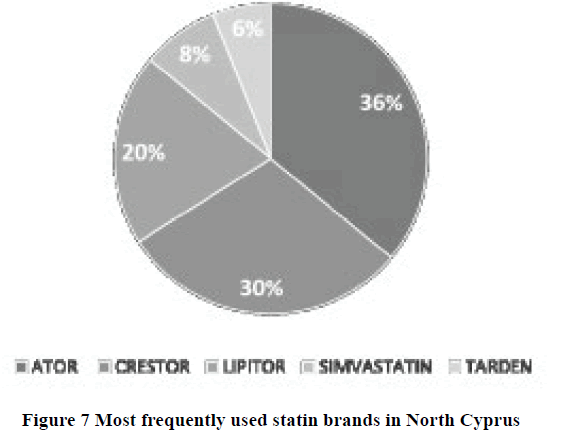Research - International Journal of Medical Research & Health Sciences ( 2020) Volume 9, Issue 8
A Pilot Study: Consumptions of Statins in Morocco and North Cyprus
Khalid EL Hassouni and Hurmus Refiker*Hurmus Refiker, Faculty of Pharmacy, Near East University, Nicosa, North Cyprus Mersin, Turkey, Tel: 90 (392) 223 64 64, Email: hurmus.refiker@neu.edu.tr
Received: 16-Jun-2020 Accepted Date: Aug 04, 2020 ; Published: 11-Aug-2020
Abstract
Background: Cholesterol lowering drugs, statins, are a major and dominant group of hypolipidemics and are often prescribed in clinical practice for the prevention and treatment of cardiovascular diseases. Objective: To assess the consumption of statins, more specifically rosuvastatin, atorvastatin and simvastatin in two different countries; Morocco and North Cyprus.
Setting: The study was conducted in Pharmacy Kounouz, Rabat, Morocco and Pharmacy Umut ÖKSÜZ in Nicosia North Cyprus. During the period of November, December 2018 and January 2019.
Method: This study involves a sample of 100 patients of pharmacy Kounouz, Rabat Morocco and Pharmacy Umut ÖKSÜZ, Nicosia, North Cyprus, who were on regular therapy with statins (Atorvastatin, Simvastatin or Rosuvastatin) in the mentioned period.
Main Outcome Measures: The difference in the frequency distribution of gender in the sample was visible in both countries where males represent a larger part of patients under statins treatment. Presence of remarkable difference between the consumption of atorvastatin, simvastatin and rosuvastatin in both countries.
Results: The most common prescribed statin dose was 10 mg in North Cyprus, while in Morocco the most common dose was 20 mg. In this sample of patients, considering the prescribed doses in relation to gender, the female patients are prescribed somewhat lower doses of statins than male patients.
Conclusion: While in North Cyprus, the most frequently prescribed drug was atorvastatin, in Morocco, rosuvastatin was most frequently prescribed statin.
Keywords
North cyprus, Statins, Morocco, Cholesterol, Cardiovascular diseases
Introduction
Statins or HMG-CoA reductase inhibitors are the most important group of hypolipidemics nowadays. They are used to lower cholesterol levels in the body and have become first-line drugs for patients at high risk of atherosclerotic cardiovascular disease. Because of their efficacy, their consumption is growing rapidly and they became one of the most commonly used drug groups, mainly in western countries where the problem of hyperlipoproteinemia is most pronounced [1-3]. Statins were discovered by Akira Endo and Masao Kuroda from Tokyo in 1971. They investigated certain microorganisms and found that they are treating substances that act as inhibitors of the enzymes of other microorganisms. These substances were actually used to protect mold from other fungi. Namely, they blocked the enzymes that synthesize mevalonate, a compound that is the precursor of ergosterol, an integral part of the cell wall of many microorganisms. These insights have opened the approach to the thesis that such substances could block the enzyme that is a part of the mechanism for the synthesis of cholesterol in the human liver. The first such compound was mevastatin, a substance secreted by the mold Penicillium citrinum. Shortly afterwards, lovastatin was isolated from the mold Aspergillus terreus, and been the first statin that passed all clinical trials and became a drug available on the market [4-6]. After the great success of lovastatin, other statins, such as atorvastatin, simvastatin, pravastatin, cerivastatin, fluvastatin and the newest rosuvastatin, are now also available on the market. Today, statins, despite their very high cost, are highly prescribed drugs, especially in developed countries where the incidence of atherosclerosis and hyperlipoproteinemia is very high [7-9].
Statins are a heterogeneous group of drugs that varies according to: a) the way they are obtained by natural process, fermentation, as mushroom products (lovastatin, simvastatin, pravastatin) or synthetic methods (atorvastatin, fluvastatin, rosuvastatin), b) structural-physicochemical properties, c) clinical effects that derive from these properties [10]. According to lipophilicity, statins are divided into lipophilic (atorvastatin, lovastatin, simvastatin) and hydrophilic (pravastatin, rosuvastatin) [10,11].
Numerous statin studies have been verified on patient population without evidence of disease control over the last two or more decades. Most of them showed a reduction in total and cardiac mortality in the group of patients treated with statins considering placebo, and some were even discontinued prior to the planned completion due to significant benefit in the group of patients treated with statins [12-14]. In the primary prevention of cardiovascular disease, nowadays a table for assessing the global risk for the development of illnesses is routinely used and every potential patient is treated individually. Based on 12 European cohort studies, a SCORE (Systemic Coronary Risk Assessment) system has been introduced, enabling a ten-year risk assessment, especially for the European high-risk region (Northern Europe and Transition Countries) and low risk [15]. Recommended values of LDL cholesterol in primary prevention of cardiovascular diseases: a) moderate risk patients (SCORE>1%-5%); <3.0 mmol/l, b) high risk for developing disease (SCORE ≥ 5to<10%): LDL cholesterol<2.5 mmol/l [16].
In patients with proven cardiovascular disease, the risk of heart attack, stroke, or sudden death is very high. It is therefore necessary to protect these patients as much as possible from such unwanted events. Meta-analysis of large “statin” studies in secondary prevention has undoubtedly shown a decrease in mortality in patients treated with statins [17,18]. Recommended values of LDL cholesterol in secondary prevention of cardiovascular disease, ie for patients with proven coronary, carotid or significant atherosclerotic peripheral artery disease, abdominal aorta aneurysm, chronic renal insufficiency, type 2 diabetes or very high risk for cardiovascular disease development (total SCORE>10%): LDL cholesterol<1.8 mmol/l or need to beloweredby at least 50% of the measured values prior to treatment [16]. Regardless of where the stage of prevention or developed cardiovascular disease is found by a particular patient, except statin therapy, they should always be encouraged to pursue an active non-sedentary lifestyle, i.e., regular physical activity due to positive effects on lipid profile [19,20] and thus long-term treatment outcomes.
The aim of this study was to conduct a research in order to determine and compare the consumption of statins, more specifically rosuvastatin, atorvastatin and simvastatin in two different countries; Morocco and Northern Cyprus.
Ethics Approval
Confidentiality was assured during the study for patient’s privacy. No patient’s addresses and other nonclinical personal information were reported.
Impacts on Practice
• Significant difference in consumption of statin molecules was recorded in both countries
• In both countries, more male patients were present
Methods
The study was conducted in Pharmacy Kounouz, Rabat, Morocco and Pharmacy Umut ÖKSÜZ in Nicosia, North Cyprus during the period of November, December 2018 and January 2019. It involves a sample of 100 patients of pharmacy Kounouz, and Pharmacy Umut ÖKSÜZ, who were on regular therapy with statins (Atorvastatin, Simvastatin or Rosuvastatin) in the mentioned period. All the patients who came to the listed pharmacies and have been dispensed with statins, their data were prospectively collected using a survey table where the gender, age and dose of the drug were required. At the end of data collection, all the tables and information were analyzed and organized for an efficient statistical processing.
The obtained results of the research were stored in MS Excel (Microsoft Excel version 16, Microsoft Corporation, Redmond WA, USA), and for the statistical analysis of the obtained data, the R software was used (R Development Core Team, 2016). The data analysis used the methods of descriptive statistics, ANOVA and Student t-test to test the main effect of gender group or locations and to assess the differences between locations. The package car (Fox and Weisberg, 2011) was used in R software [21,22].
Results
Out of the total number of patients (N=100), data from 50 (50%) patients from Pharmacy Kounouz Morocco and 50 (50%) of patients from Pharmacy Umut ÖKSÜZ TRNC were collected. As shown in Figure 1, in Pharmacy Kounouz, 57% of cases were male, and in 43% of cases were female, while in Pharmacy Umut ÖKSÜZ 70% of patients were male and 30% female (Figure 1). The difference in frequency of distribution in relation to gender in the sample was slightly significant in North Cyprus comparing to Morocco, and it can be said that in both countries more male patients were present.
The patients in sample were from different ranges of age in both countries. In Figure 2, it was demonstrated that Morocco got female patients with a minimum age of 55 years old and the majority consumers within the age group of (65- 70). While male patients starting from 45 years old and majority belongs to the age groups (65-75). In addition a gap in the age group of (60-65) was achieved most probably due to the smaller number of patients in the sample (Figure 2).
In case of North Cyprus, younger female patients from an early age of 30 years old and a large group of age of (45-50) have been reported. While male patients are with a minimum age of 40 years old and a prominent majority of statins consumers among the age group of (55-60) (Figure 3).
According to statin consumption in Pharmacy Umut ÖKSÜZ TRNC, atorvastatin was the most frequent at 62.5 %, while the other, simvastatin and rosuvastatin were in a low percentage as exhibited in Figure 4. Conversely, in Pharmacy Kounouz Morocco, rosuvastatin was the most frequent 44%, while others had a similar low value as shown in Figure 5. By comparing the statin consumption in both countries, it can be said that there is a significant difference in the statins molecules consumed in both countries and that atorvastatin is the most prescribed one in TRNC while rosuvastatin is the most prescribed in Morocco (Figures 4 and 5).
When the statin consumption was investigated in relation to the brand name, as represented in Figure 6, “Ator” was the most commonly used brand, 36% in Pharmacy Umut ÖKSÜZ, North Cyprus, “Crestor” 30% and “Lipitor” 17.10%, while others were at a slightly lower percentage. At Pharmacy Kounouz Morocco, “Crestor” was the most commonly consumed brand 44%, then “Tahor” 30% and “Redlip” 16%, while the others were at a lower percentage as expressed in Figure 7.
Table 1 expresses the overview of the most frequently prescribed statin doses where in Pharmacy Umut ÖKSÜZ, the most common dose was 10 mg, while in Pharmacy Kounouz Morocco the most common dose was 20 mg. In this sample of patients, considering the prescribed doses in relation to gender, it can be concluded that there is a statistically significant difference in the prescribing of higher or lower doses according to gender. The female patients are prescribed somewhat lower doses of statins than male patients.
| Dosage (mg) | Morocco | North Cyprus | ||
|---|---|---|---|---|
| f | % | f | % | |
| 5 | 7 | 14% | 10 | 20% |
| 10* | 15 | 30% | 33 | 66% |
| 20* | 20 | 40% | 7 | 14% |
| 40 | 2 | 4% | - | - |
| 80 | 6 | 12% | - | - |
f: frequency; *: mostly prescribed statin doses in Morocco and North Cyprus
Discussion
Cholesterol lowering drugs, so-called statins, are an inescapable foundation and are often prescribed in clinical practice for the prevention and treatment of cardiovascular disease [16,23]. Over the last two decades prescription of statins in the US has risen to about 100 million prescriptions per year. In spite of this, it is estimated that almost 50% of people who benefit from their use do not use the statins, and those who take them apply them in inappropriate, low doses [24]. The aim of this study was to determine and compare the consumption of atorvastatin, simvastatin and rosuvastatin in two different countries, Morocco (Pharmacy Kounouz, Rabat) and Northern Cyprus (Pharmacy Umut ÖKSÜZ, Nicosia). The study showed that there was a visible difference between the consumption of atorvastatin, simvastatin and rosuvastatin. Atorvastatin was the most commonly prescribed drug in Northern Cyprus, while in Morocco it was rosuvastatin. Furthermore, the study showed that there was a difference in the prescribed statin doses in the mentioned pharmacies and in the prescribing of higher or lower doses by gender. The female patients were prescribed a lower statin dose compared to the male patients, where statin doses of 10 mg were more often prescribed in Northern Cyprus, while the statin doses of 20 mg in Morocco. Statistics also show that in this case, however, the female patients consumed more statins than the male patients, although men tend to have higher incidence of dyslipidemia and cardiovascular disease. It can be concluded that statins are an important group of drugs that effectively lower the level of cholesterol in the body, and can also be used to treat atherosclerosis as well as its prevention, and the prevention of cardiovascular and stroke as a possible consequence of atherosclerosis.
The increased consumption of a specific statin molecule like atorvastatin or rosuvastatin in the investigated countries could be an indication of the still insufficiently rational prescription of these drugs by the physicians and that the consumption of all statins should be balanced regardless of the manufacturer. Although recent research has shown a greater benefit of intense moderate statin dosing, dosing should be consistent with individual patient characteristics and appropriate for primary and secondary prevention of cardiovascular disease. Ultimately, it should be emphasized that, regardless of therapy, patients should always be encouraged to participate in an active lifestyle, which means maintaining regular physical activity because of its clear positive effects in prevention and in the treatment of dyslipidemia and cardiovascular diseases.
Some of the major limitations of the current study many limitations of this study might be the potentially insufficient number of patients, the small time span of the study, the possibility of taking into account some other parameters such as; drugs in the treatment of patients that are most often involved in interaction with statins including OTC and herbal medications, monitor potential adverse effects of patients and the impact of therapy on the development of adverse reactions and treatment success. Despite the limitations of the study, we believed this way, at least in a way, we have contributed to raising awareness about the importance of statins and their public health significance in the fight against the risk factors that cause cardiovascular disease, especially hypercholesterolemia.
Conclusion
The survey was conducted on a sample collection of 100 patients, 50% of the data was conducted from Pharmacy Kounouz in Morocco and 50% from Pharmcy Umut ÖKSÜZ in Northern Cyprus. In both countries, female patients were the biggest consumers of statins. In Northern Cyprus, most frequently prescribed drug was atorvastatin followed by rosuvastatin, while simvastatin was used very rarely. In Morocco, rosuvastatin was most frequently prescribed statin, while atorvastatin and simvastatin showed a slightly similar rate of consumption. The most frequently pre scribed statin according to brand name was “Crestor” in Morcco, while in Northern Cyprus it was “Ator”. In case of prescribed statin dosages the most frequently prescribed dosage was 20 mg in Morocco, while in Northern Cyprus it was 10 mg.
Declarations
Acknowledgement
Authors are thankful to Pharmacy Umut ÖKSÜZ, Nicosia North Cyprus and Pharmacie Kounouz, Rabat Morocco for cooperation in collecting the necessary data for the study.
Conflicts of Interest
The authors declared no potential conflicts of interest with respect to the research, authorship, and/or publication of this article.
References
- Grundy, Scott M. "HMG-CoA reductase inhibitors for treatment of hypercholesterolemia." New England Journal of Medicine, Vol. 319, No. 1, 1988, pp. 24-33.
- Pedersen, Terje R., and Jonathan A. Tobert. "Benefits and risks of HMG-CoA reductase inhibitors in the prevention of coronary heart disease." Drug Safety, Vol. 14, No. 1, 1996, pp. 11-24.
- Expert Panel on Detection, Evaluation. "Executive summary of the third report of the National Cholesterol Education Program (NCEP) expert panel on detection, evaluation, and treatment of high blood cholesterol in adults (Adult Treatment Panel III)." JAMA, Vol. 285, No. 19, 2001, p. 2486.
- Endo, Akira, Masao Kuroda, and Kazuhiko Tanzawa. "Competitive inhibition of 3-hydroxy-3-methylglutaryl coenzyme A reductase by ML-236A and ML-236B fungal metabolites, having hypocholesterolemic activity." FEBS Letters, Vol. 72, No. 2, 1976, pp. 323-6.
- Endo, Akira. "The discovery and development of HMG-CoA reductase inhibitors." Journal of Lipid Research, Vol. 33, No. 11, 1992, pp. 1569-82.
- Endo, Akira. "The origin of the statins." International Congress Series. Vol. 1262. Elsevier, 2004.
- Peto, R., S. Yusuf, and R. Collins. "Cholesterol-lowering trial results in their epidemiologic context." Circulation, Vol. 72, No. 4, 1985, p. 451.
- Unit, Epidemiological Studies. "Efficacy and safety of cholesterol-lowering treatment: Prospective meta-analysis of data from 90056 participants in 14 randomised trials of statins." Lancet, Vol. 366, No. 9493, 2005, pp. 1267-78.
- National Cholesterol Education Program (NCEP). "Expert panel on detection, evaluation, and treatment of high blood cholesterol in adults (Adult Treatment Panel III)." Circulation, Vol. 106, 2002, pp. 3143-421.
- Frishman, William H., and John Horn. "Statin-drug interactions: Not a class effect." Cardiology in Review, Vol. 16, No. 4, 2008, pp. 205-12.
- Neuvonen, Pertti J. "Drug interactions with HMG-CoA reductase inhibitors (statins): The importance of CYP enzymes, transporters and pharmacogenetics." Current Opinion in Investigational Drugs (London, England: 2000), Vol. 11, No. 3, 2010, pp. 323-32.
- Shepherd, James. "West of Scotland Coronary Prevention Study Group: Prevention of coronary heart disease with pravastatin in men with hypercholesterolemia." The New England Journal of Medicine, Vol. 333, 1995, pp. 1301-7.
- Ridker, P. M., E. Danielson, and F. A. Fonseca. "JUPITER Study Group Rosuvastatin to prevent vascular events in men and women with elevated C-reactive protein." The New England Journal of Medicine, Vol. 359, 2008, pp. 2195-207.
- Sever, Peter S., et al. "Prevention of coronary and stroke events with atorvastatin in hypertensive patients who have average or lower-than-average cholesterol concentrations, in the Anglo-Scandinavian Cardiac Outcomes Trial-Lipid Lowering Arm (ASCOT-LLA): A multicentre randomised controlled trial." The Lancet, Vol. 361, No. 9364, 2003, pp. 1149-58.
- Peršić, V., et al. "Cardiovascular prevention and rehabilitation: Where are we and where are we heading to?" Cardiologia Croatica, Vol. 7, No. 5, 2012, pp. 158-69.
- Reiner, Željko, et al. "ESC/EAS Guidelines for the management of dyslipidaemias: The Task Force for the management of dyslipidaemias of the European Society of Cardiology (ESC) and the European Atherosclerosis Society (EAS)." European Heart Journal, Vol. 32, No. 14, 2011, pp. 1769-818.
- Marchioli, Roberto, et al. "Meta-analysis, clinical trials, and transferability of research results into practice: The case of cholesterol-lowering interventions in the secondary prevention of coronary heart disease." Archives of Internal Medicine, Vol. 156, No. 11, 1996, pp. 1158-72.
- Wilt, Timothy J., et al. "Effectiveness of statin therapy in adults with coronary heart disease." Archives of Internal Medicine, Vol. 164, No. 13, 2004, pp. 1427-36.
- Lakusic, Nenad, and Darija Granec. "Improvement in lipid profile of patients referred to a cardiac rehabilitation program: Is the effect of regular exercise underestimated because of the antilipid drugs?" European Journal of Cardiovascular Prevention and Rehabilitation, Vol. 16, No. 1, 2009, pp. 114-6.
- Mahović, Darija, et al. "The effect of 3-weeks stationary cardiac rehabilitation on plasma lipids level in 444 patients with coronary heart disease." Collegium Antropologicum, Vol. 28, No. 2, 2004, pp. 623-9.
- Team, R. Core. "R: A language and environment for statistical computing." R found. Stat. Comput, Vienna, 2013.
- Fox, J., and S. Weisberg. "An R Companion to Applied Regression, 2nd edn. Sage." Thousand Oaks CA, 2011.
- Roffi, Marco, et al. "2015 ESC Guidelines for the management of acute coronary syndromes in patients presenting without persistent ST-segment elevation: Task force for the management of acute coronary syndromes in patients presenting without persistent ST-segment elevation of the European Society of Cardiology (ESC)." European Heart Journal, Vol. 37, No. 3, 2016, pp. 267-315.
- Schwandt, Peter, and Adrian JB Brady. "Achieving lipid goals in Europe: How large is the treatment gap?" Expert Review of Cardiovascular Therapy, Vol. 2, No. 3, 2004, pp. 431-49.

